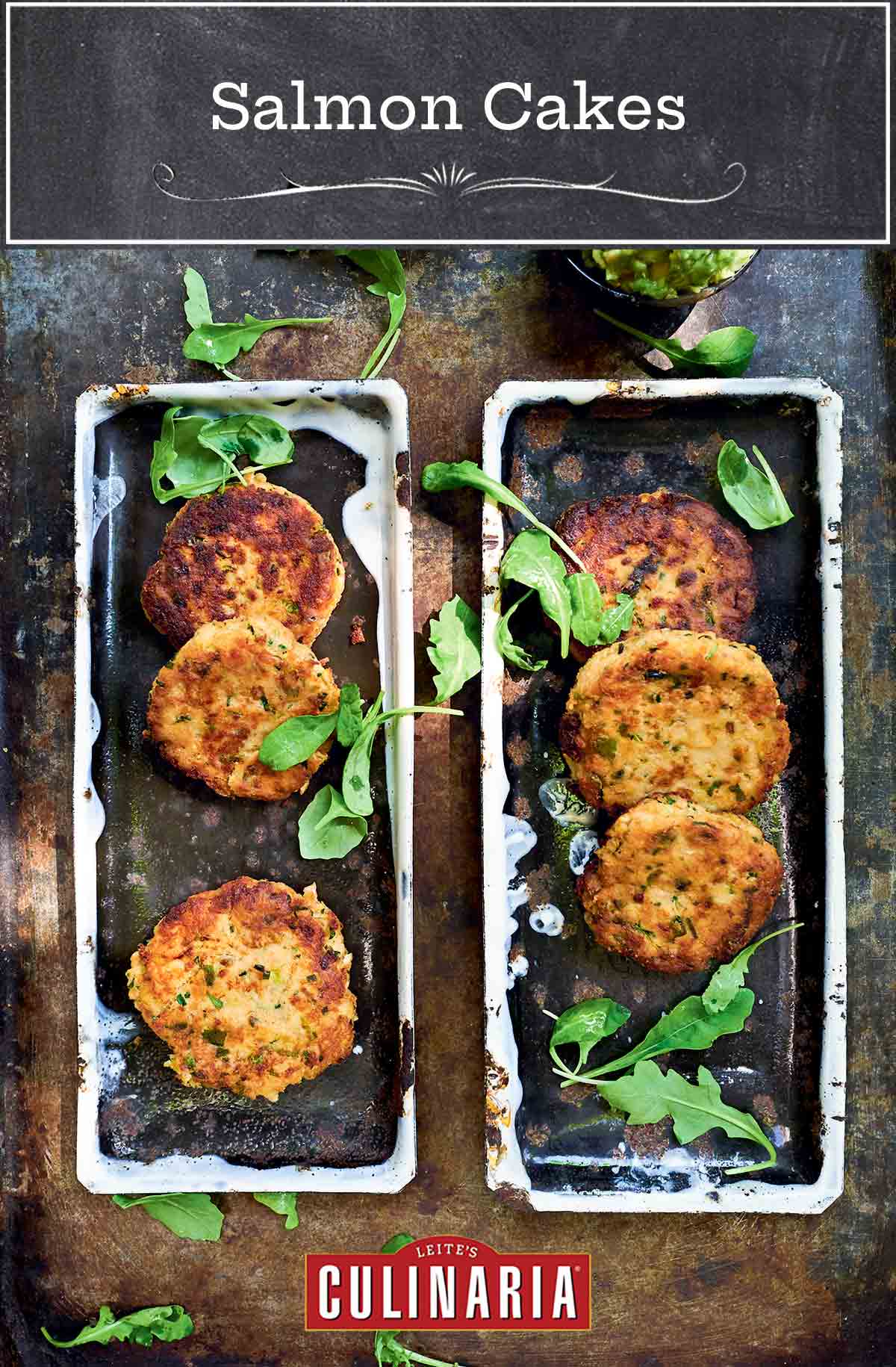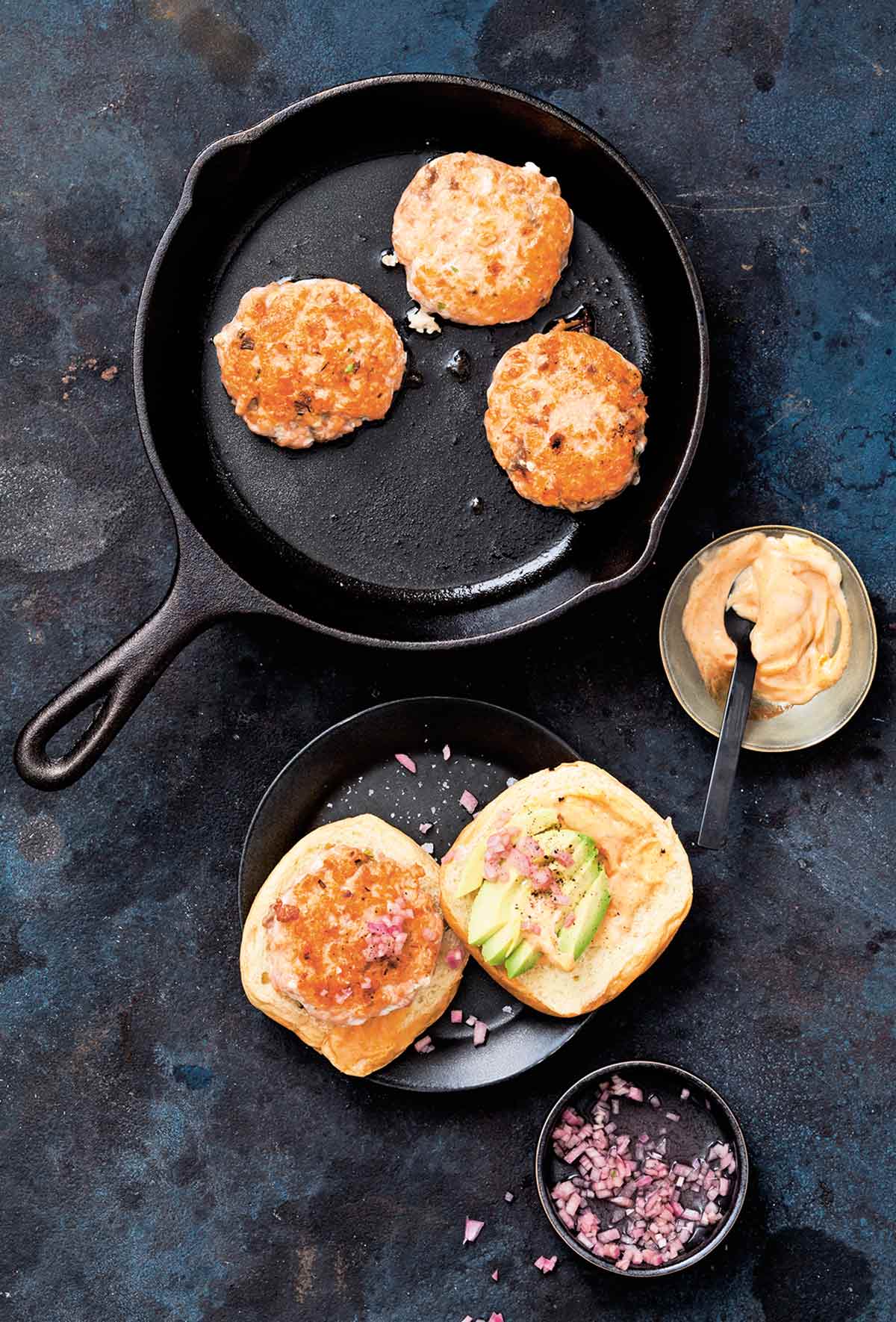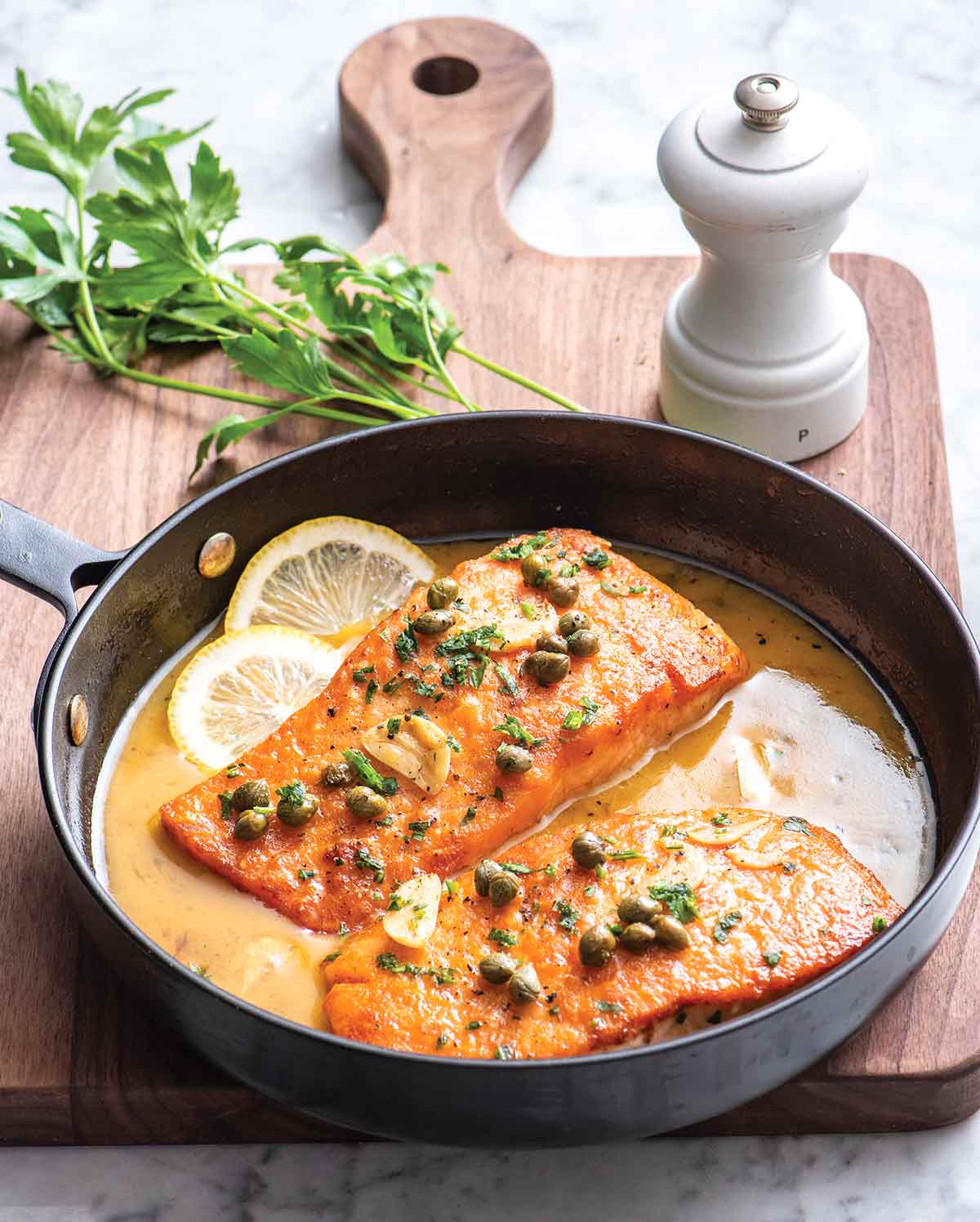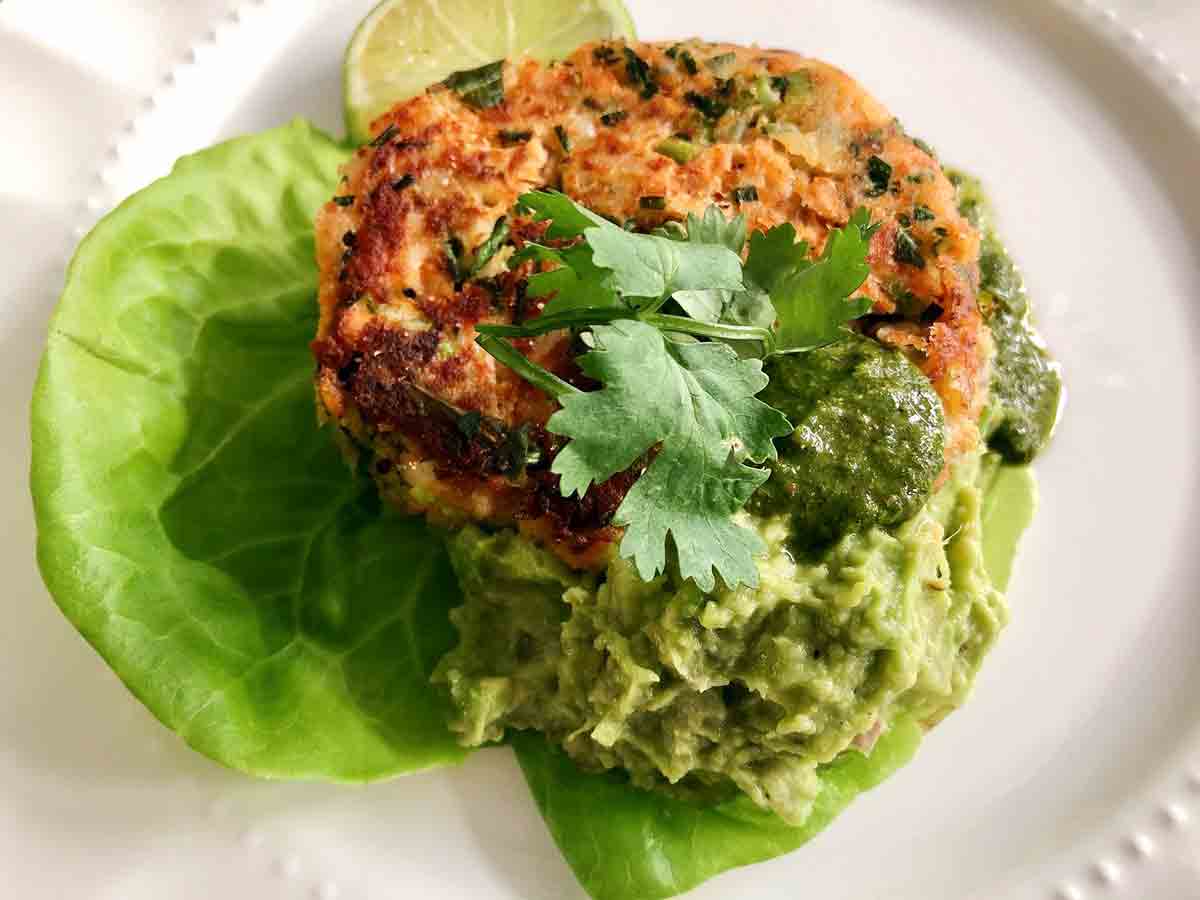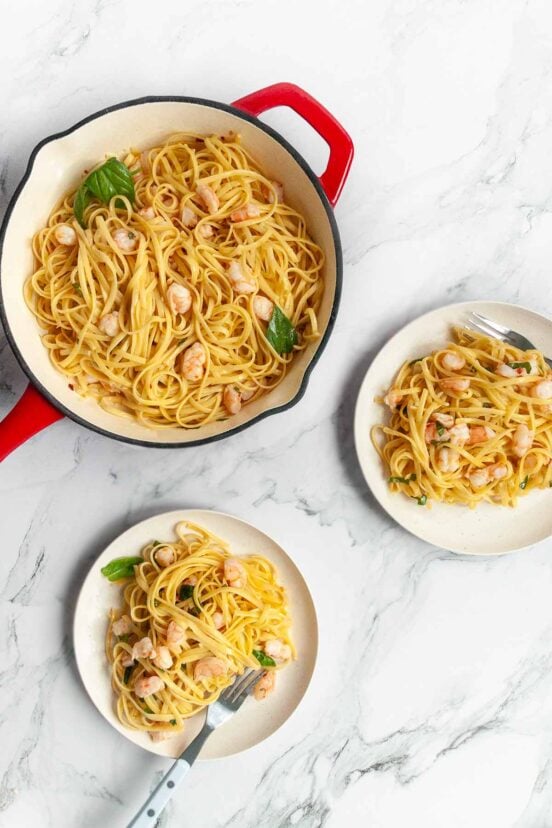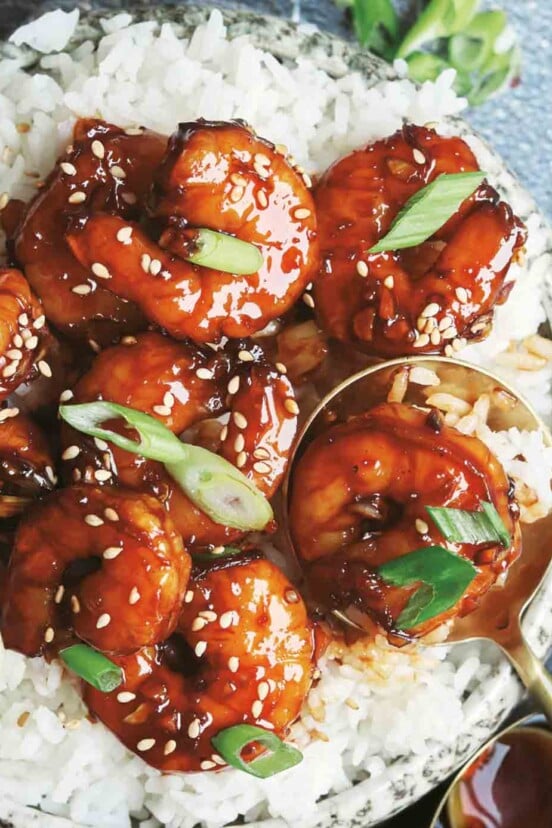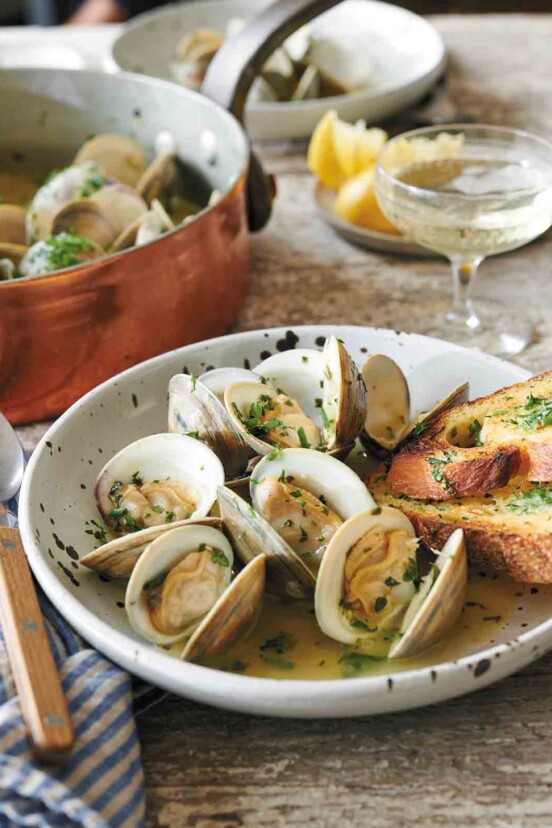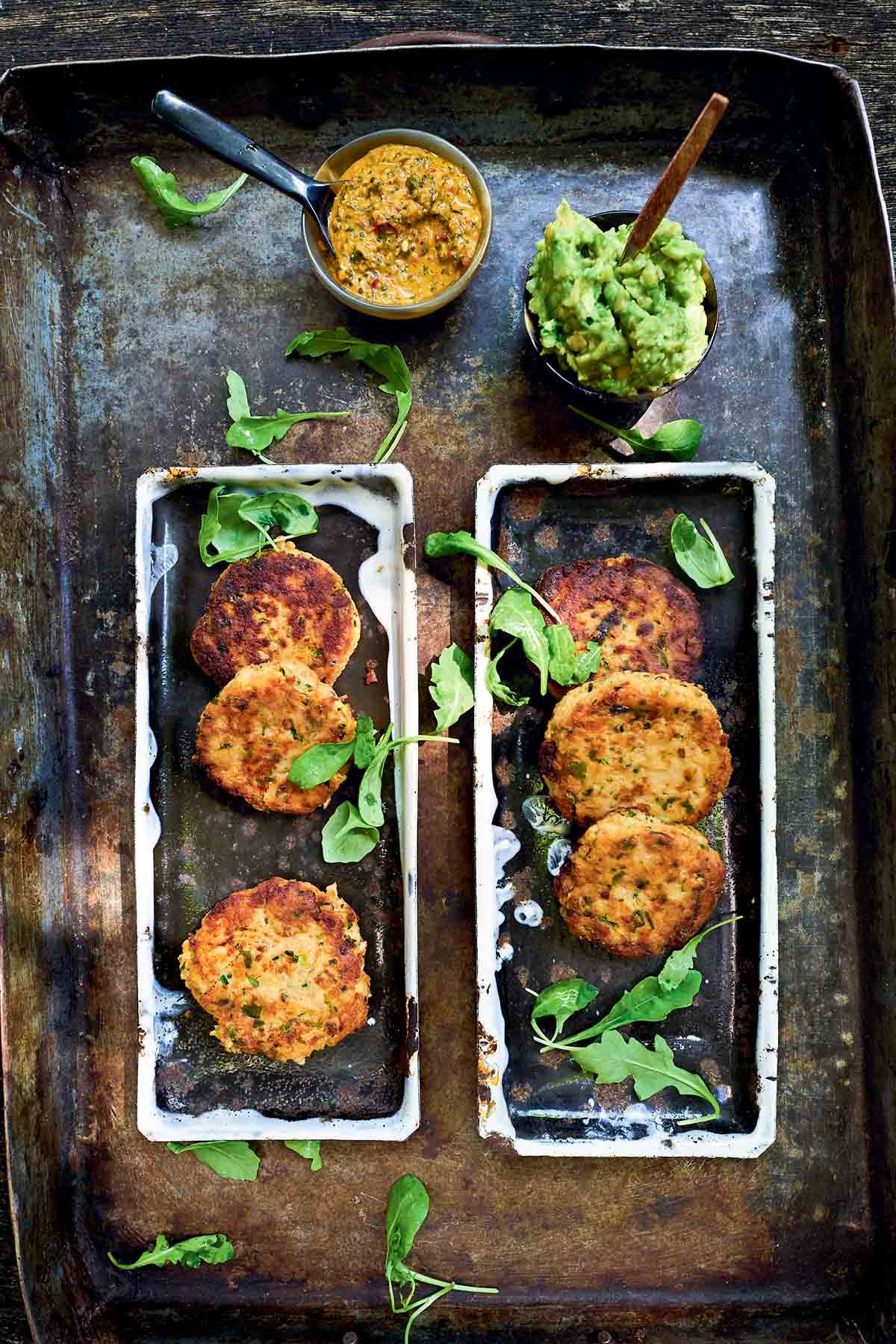
This salmon cakes recipe zhuzhes up boring ole canned salmon beyond recognition and will banish all past recollections (nightmares?!) of Fish Friday. For good.

Why Our Testers Loved This
Our testers were delighted to discover a recipe that elevates canned salmon cakes to a restaurant-quality dish.
Ilda Costa-Sarnicki has this to say about the flavor of these cakes: “There were layers of intricate, subtle, and more forward flavors that all married into an exciting final dish.“
What You’ll Need to Make This
- Russet potatoes–Don’t substitute red or other waxy potatoes here, as the cakes won’t hold together.
- Chives–If you don’t have chives on hand, add an extra scallion to the mixture.
- Canned salmon–Use the absolutely best quality canned salmon that you can find. You can also use fresh or leftover roasted or grilled salmon in place of canned salmon.
How to Make This Recipe
- Cook the potatoes. Boil the potato halves in salted water until tender. Drain and let cool.
- Make the salmon patties. Mash the potatoes with the scallion, arugula, chives, and cayenne, then mix in the egg and salmon. Shape the mixture into patties, then cover and chill for 30 minutes.
- Make the avocado spread. Combine the avocado, shallot, lemon juice, and olive oil. Mash until smooth and season with salt and pepper.
- Blend the chimichurri. Dump the chimichurri ingredients in a food processor and blitz until smooth.
- Fry the salmon patties. Heat a splash of oil in a skillet and fry the cakes until golden brown, flipping once. Drain on a paper bag before serving with the avocado spread and chimichurri.
Common Questions
Salmon patties can be quite fragile and can crumble. It’s important to chill them in the fridge for at least 30 minutes before pan-frying. If they are still crumbly, try adding some bread crumbs or panko as an additional binder.
Sure. We love the freshness that the avocado dip and chimichurri sauce provide, but feel free to serve these with a squeeze of lemon, a spicy mayo, or some homemade tartar sauce.
Our testers enjoyed these with arugula salad, but they’d be great stuffed inside a hamburger bun or plopped on top of a slice of toasted French bread.
Helpful Tips
- The avocado dip and chimichurri sauce make enough for two batches of salmon cakes.
- Be gentle when handling and flipping the salmon patties, as they can crumble. Our testers recommend using a nonstick pan and a flexible fish spatula.
- Leftover cooked salmon patties can be stored in a sealed container, in the refrigerator, for up to 3 days or frozen for up to 3 months. If frozen, defrost in the refrigerator overnight. Reheat in a skillet over medium-low heat or in a warm oven.
- To make gluten-free salmon cakes, replace the all-purpose flour, if using, with gluten-free flour.
- The recipe is suitable for dairy-free diets.
Write a Review
If you make this recipe, or any dish on LC, consider leaving a review, a star rating, and your best photo in the comments below. I love hearing from you.–David
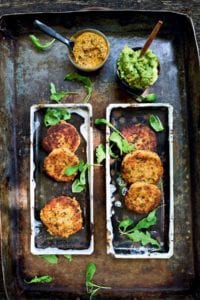
Salmon Cakes
Ingredients
For the salmon cakes
- 1/2 pound russet potatoes, peeled and halved (about 1 large)
- Sea salt
- 2 scallions, white and light green parts, thinly sliced
- Handful of arugula, coarsely chopped
- 1/4 cup (1/2 oz) chives, finely chopped
- 1 teaspoon cayenne pepper
- Freshly ground black pepper, to taste
- 1 large egg, beaten
- One (6 ounce) can of salmon, drained and picked clear of any bones
- Sunflower oil, for frying
- Flour, for dusting (optional)
- 1/2 lime
For the avocado spread
- 1 avocado, pitted
- 1/2 shallot, finely diced
- Juice of 1 lemon
- 1 tablespoon olive oil
- Salt and freshly ground black pepper, to taste
For the chimichurri
- 1/2 red chile pepper, seeded, or a pinch crushed red pepper flakes
- 1 garlic clove
- 2 teaspoons dried oregano
- 1 shallot, halved
- 1/4 inch piece ginger, peeled and coarsely chopped
- 1 bunch of mint, leaves only (about 1 cup loosely packed)
- 1 bunch of cilantro
- Juice of 2 lemons
- 2 tablespoons red wine vinegar
- 2 tablespoons olive oil
Instructions
Assemble the salmon cakes
- In a medium saucepan over high heat, combine the potato with enough water to cover by 1 inch and season generously with salt. Bring to a boil, reduce heat to maintain a simmer, and cook until the potato is tender, 15 to 20 minutes. Drain and let cool.
- In a large bowl, roughly mash the potato, then mix in the scallion, arugula, chives, and cayenne pepper. Season with salt and pepper.
- Add the egg and the salmon and mash with a fork until everything comes together in a coarse mixture.
- Shape the potato-salmon mixture into balls that fit in the palm of your hand and then flatten them until they’re between 1/2 and 3/4 inch (12 and 18 mm) thick. The salmon patties will be fragile. Place on a plate, loosely cover, and slip in the fridge for 30 minutes.
Make the avocado spread
- In a medium bowl, mash the avocado with the shallot, lemon juice, and some olive oil, and season with salt and pepper.
Make the chimichurri
- Purée all the ingredients in a food processor until mostly smooth or the desired consistency, 2 to 3 minutes. Drizzle in a little extra olive oil if the sauce is too thick.
Fry the salmon cakes
- In a heavy-bottomed skillet over medium heat, warm a splash of sunflower oil. Dust the patties with a bit of flour, if using. Carefully add the cakes to the skillet and fry util golden brown on 1 side, 3 to 4 minutes.
- Carefully flip with a spatula and fry on the other side for 3 to 4 more minutes. The cakes should be nice and hot inside.
☞ TESTER TIP: These salmon cakes are quite delicate, so take extra care both when slipping them into the skillet and when flipping them.
- Lift the salmon cakes out of the pan and onto paper towels or a brown paper bag cut open. (You can also keep them warm in a low oven until the rest are cooked, if you prefer.)
- Serve with the avocado spread, chimichurri, and lime.
Notes
- Scaling the recipe–The avocado dip and chimichurri sauce for the salmon cakes make enough for a double batch of salmon cakes.
- Storage–Leftover salmon cakes can be stored in a sealed container, in the refrigerator, for up to 3 days or frozen for up to 3 months. If frozen, defrost in the refrigerator overnight. Reheat in a skillet over medium-low heat, or in a warm oven.
- Make it gluten-free–To make gluten-free salmon cakes, replace the all-purpose flour, if using, with gluten-free flour.
- Dietary–The recipe is suitable for dairy-free diets.
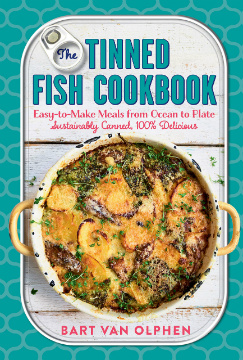
Nutrition
Nutrition information is automatically calculated, so should only be used as an approximation.
Recipe Testers’ Reviews
This recipe made me realize that I’m a salmon-cake lover. This was the kind of dish that previously didn’t excite me: Although not anti-salmon croquette, I just did not see the big deal about them.
My parents made them when I was growing up, and they’re definitely not among my top dinner memories. I decided to try this recipe because of the addition of potato as well as the fresh green components. So glad that I did!
The potato gives a lovely texture and makes the salmon cake less tight and fishy! I love all the bright components of the chimichurri and the avocado spread with their notes of lemon and acid. It was more of an elevated salmon cake and definitely something that looks and tastes like it belongs on a restaurant menu.
For the amount of work, I felt it was worth getting at least four portions (in our house, two nights of dinner for two), so I doubled the recipe. You don’t have to do the same with the chimichurri and avocado spread, as those are generous enough to stretch another night.
The photo on this salmon cakes recipe sold it for me. I was looking for a small plate, single-serving recipe that was a “looker” without too many ingredients. This recipe had the “looker” prerequisite, but it seemed to have too many components.
After a second read, I decided to treat the steps as three recipes. This made it seem so much simpler. The progression actually saved time, and after 50 minutes, I had a meal with three distinct components.
Both the avocado spread and the chimichurri could easily be paired with other recipes. I used canned wild sockeye salmon, drained, bones removed, and one large russet potato. My frying oil is grapeseed oil, so I used that. I liked that the recipe suggested refrigerating the cakes to firm them up, as this did work very well.
I opted not to flour the cakes before frying. This was the only element that I felt could have been enhanced. There was an overabundance of creamy textures. I missed a crispy crust on the salmon cakes, which perhaps the flour could have repaired. Definitely, the use of coarse bread crumbs or anything creating a crispy crust would have enhanced the experience.
As for the flavor, there were layers of intricate, subtle, and more forward flavors that all married into an exciting final dish.
This fed four as a starter on a bib lettuce leaf but would feed two as a main course.
Growing up Catholic during the season of Lenten meant meatless Friday dinners. Fish sticks, macaroni and cheese, tuna fish casserole, and sometimes, salmon cakes.
My childhood version was a mashup of creamed corn with canned salmon hung together with bread crumbs and mystery seasoning. (To this day, I’m still unsure what ingredients were included.) I tried this recipe for salmon cakes to find out if salmon cakes have improved over the years.
These salmon cakes elevate a can of fish into a restaurant-quality entrée. I was pleasantly surprised. The accompaniments—avocado spread and chimichurri—enhanced the experience that much more.
The only change I’d make is the mashing of the potato. I left chunks, which could have been smaller and worked in with the salmon better. Overall, a tasty dish that I was delighted to serve.
There are a lot of ingredients in this recipe, which is typically a hurdle for me, but many of them are ingredients most kitchens have available.
This was my first time making salmon and potato cakes. All of the hands-on work was easy. I found the cakes to be a little crumbly, but I think that’s typical of hand-shaped patties.
I loved the flavor combination of the salmon patties, the chimichurri, and the avocado spread. The chimichurri was so different than a typical version with ginger and mint. It gave an appropriate zing to the patties!
I used one russet potato. I didn’t use chives but added an additional scallion. I did dust the patties in flour. I used a pinch of crushed red pepper in the chimichurri in lieu of dried red chili pepper. One bunch of mint leaves was about 1 cup loosely packed.
I got seven cakes, and they came together easily but were fragile. They firmed up a bit in the refrigerator. I found it helpful to flatten them with a spatula once they were in the frying pan.
The cakes were hot inside when I ate them immediately after cooking. They made a great dinner over arugula salad!
These salmon cakes were delicious, and I loved that my gluten-intolerant husband could eat them without a problem.
With only the potato and egg to bind, I wasn’t convinced they’d hold together. After sitting in the fridge and firming up for 30 minutes, they did hold their shape, but I had to be GENTLE with them. I used a nonstick pan and a flexible nylon spatula to turn them, and still, the edges were a bit messy.
Both sauces were tasty, but the two together were overkill; either one on its own would have been enough. I preferred the chimichurri, and I liked the atypical touch of ginger in it.
I thought the avocado sauce was good, but it didn’t really add much to the overall dish—it just made it gloppier than it needed to be. Also, making two different sauces made this more labor intensive than necessary, especially for a weeknight-type dinner that starts out with canned salmon! This is going in our weeknight dinner rotation, but with chimichurri only!
I did use a very light fingertip pat of gluten-free flour. It didn’t cover the entire outside of the cakes; it was just enough to seal in the surface when it hit the oil.
I think this would make two main course servings or four appetizer course servings.
